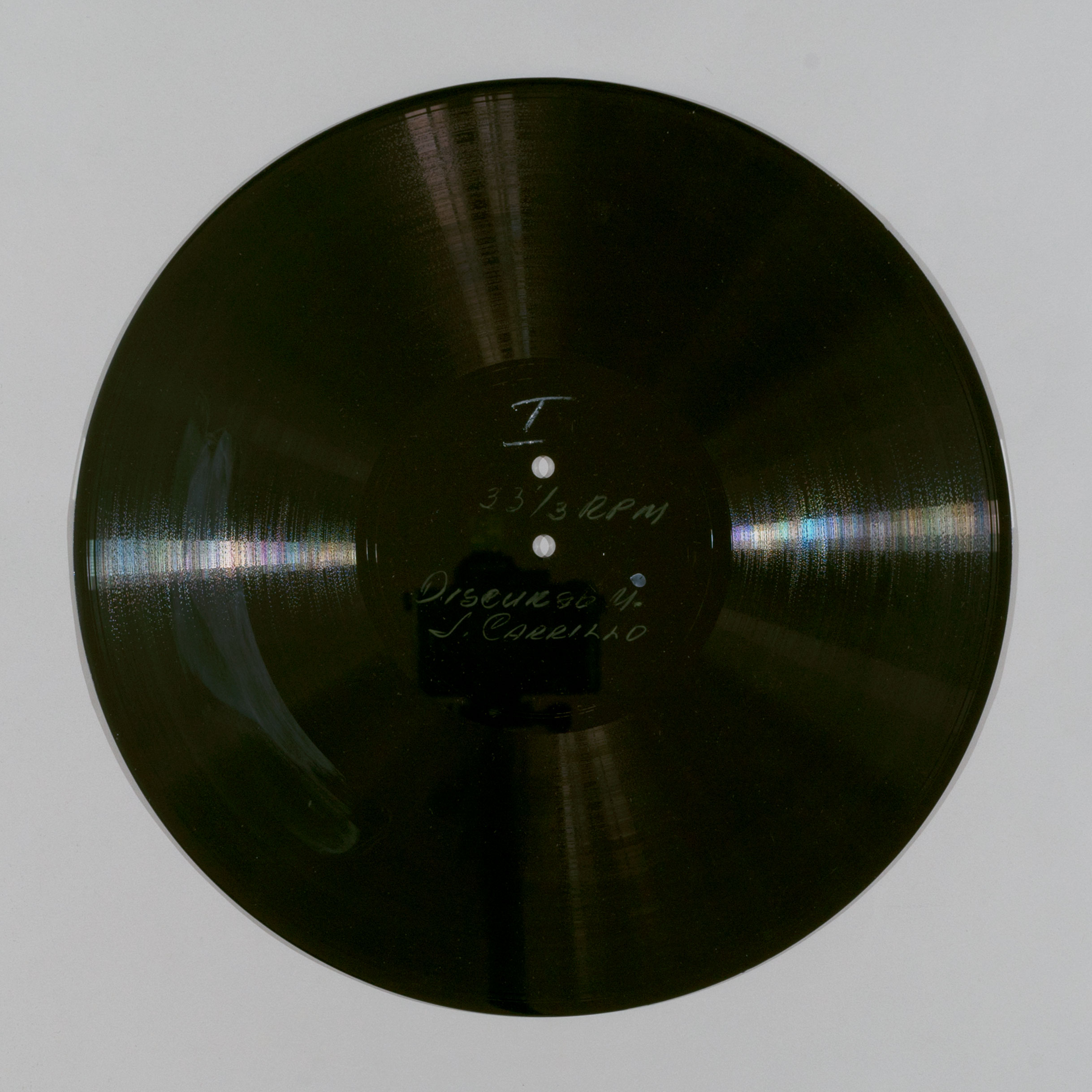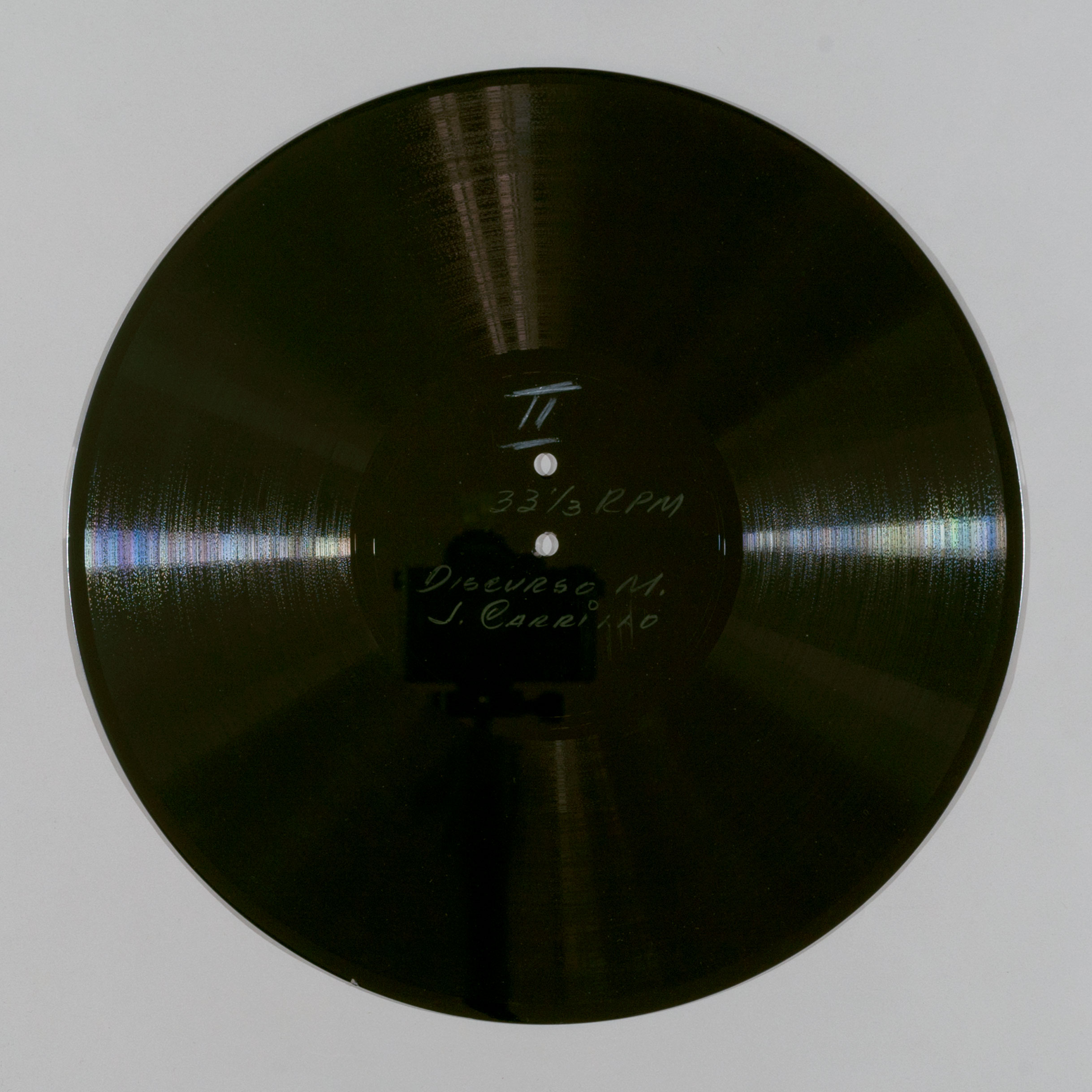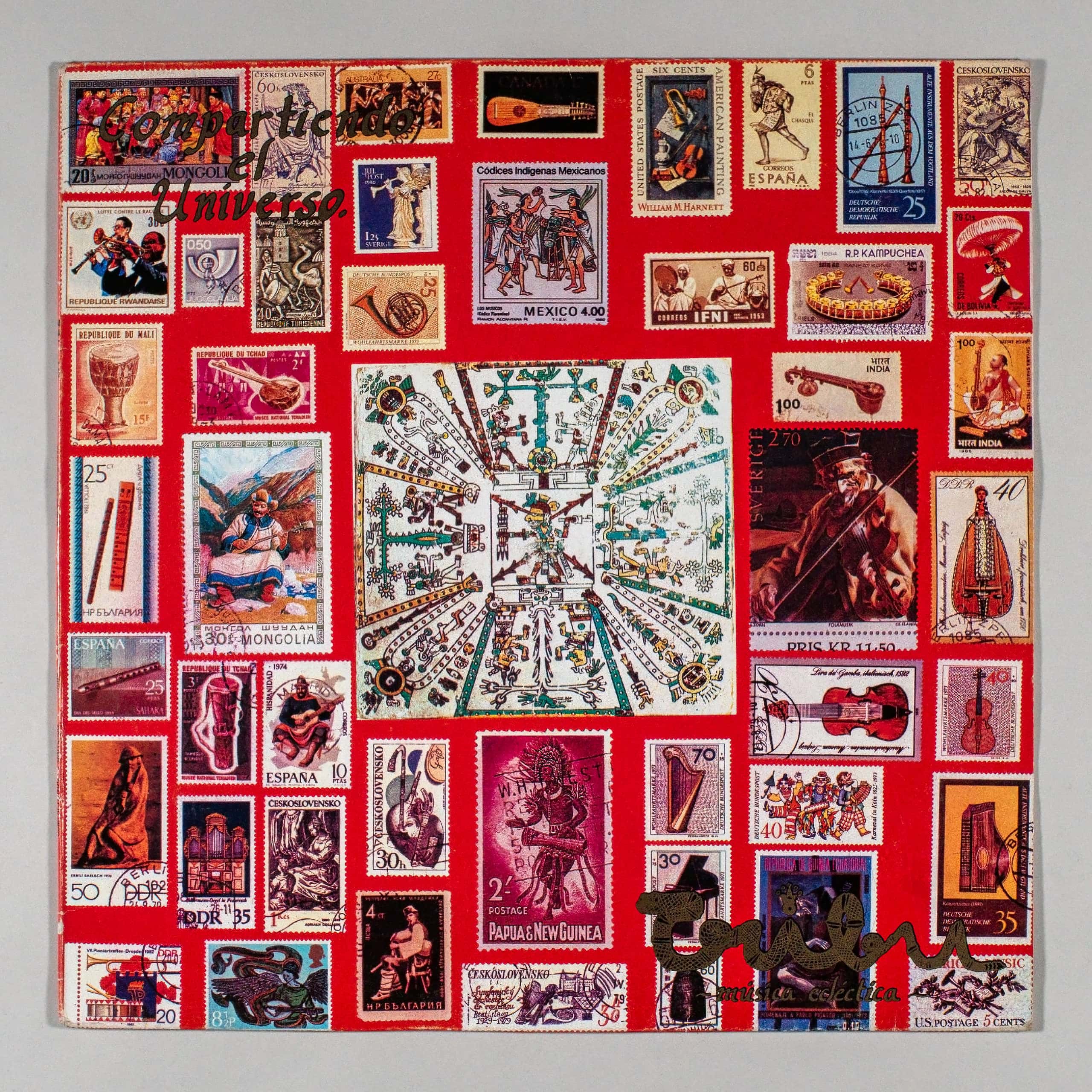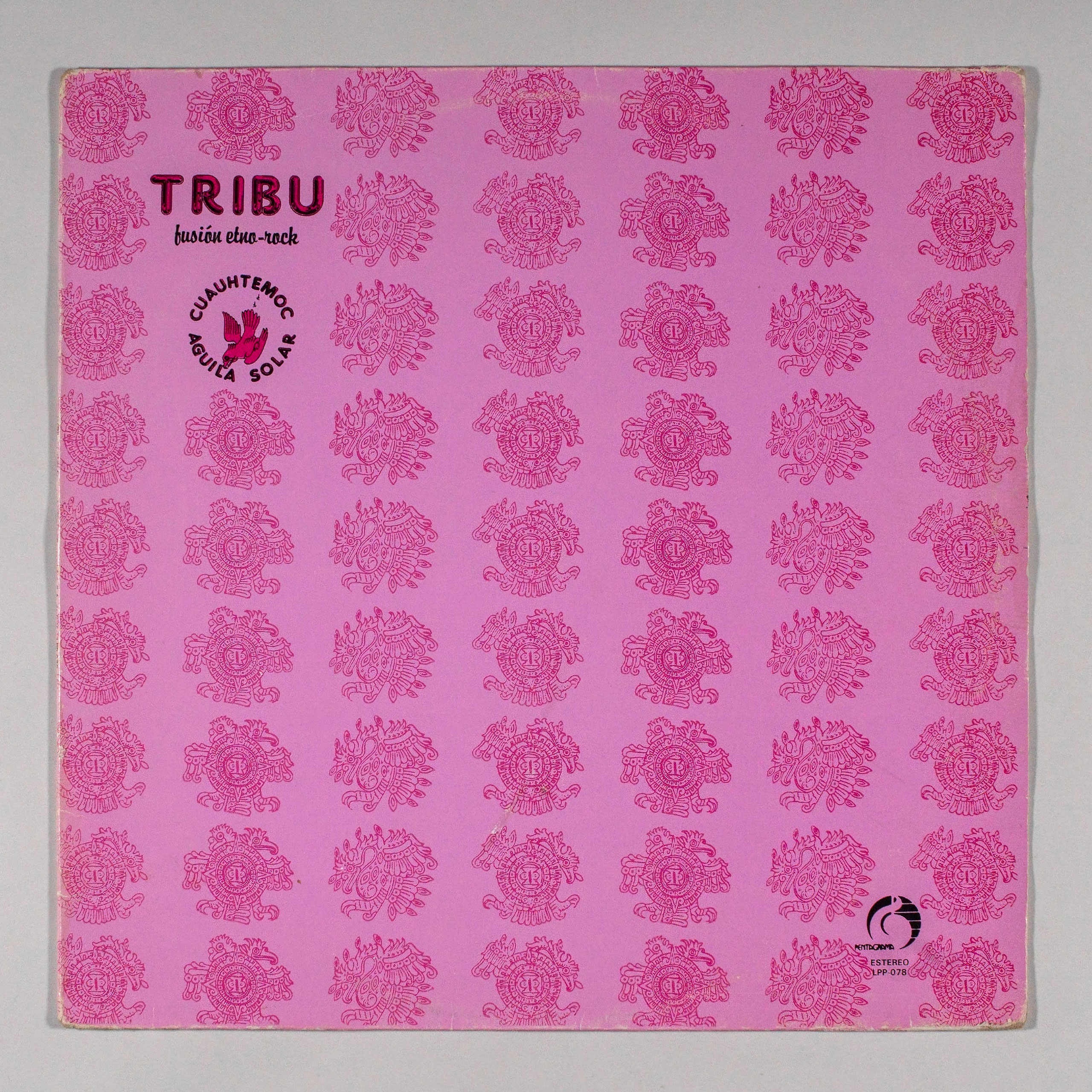
|
Format: Vinyl LP 12" 33 1/3 rpm single |
Info:
Julián Carrillo’s speech – Unreleased Disc – Ultra-Rare.
Carrillo Metamorphosing Pianos
Speech July 13, 1959 exhibition 15 metamorphosed pianos Julian Carrillo Fine arts Mexico City.
Audio:
Carrillo Metamorphosing Pianos
Speech July 13, 1959 exhibition 15 metamorphosed pianos Julian Carrillo Fine arts Mexico City.
[00:00 – 00:08] Carrillo’s Metamorphosing Pianos. In fulfillment of my commitment to the world’s musical culture,
[00:09 – 00:21] I include in this recording the speech I delivered on July 13, 1959, during the opening of the exhibition of my pianos at the Palace of Fine Arts in Mexico City.
[00:23 – 00:30] Mr. Representative of the Citizen President of the Republic, Mrs. Eva Sábano de López Mateos,
[00:30 – 00:37] esteemed State Secretaries, Mr. Rector of the National Autonomous University of Mexico,
[00:38 – 00:45] distinguished ambassadors, honored guests, ladies and gentlemen.
[00:47 – 00:57] Those of us who stir the alpha of crowds with our preachings are obliged to inform when what we promised is already happening.
[00:58 – 01:07] In this specific case, it is an honor for me to inform the Citizen President of the Republic, through the Secretary of Education,
[01:07 – 01:14] his personal representative at this ceremony, of the significance for the musical progress of the music,
[01:14 – 01:22] of the 15 Carrillo Metamorphosing Pianos exhibited here, bearing my name not out of vanity,
[01:22 – 01:35] but to distinguish them from semitones produced by Stenway, Bechstein, Gabó, etc. The achievements of this speech are as follows. Achievements in other fields of sound 13, including musical physics,
[01:35 – 01:40] will be presented in a detailed report I am preparing for the President of the Republic.
[01:42 – 01:48] The musical world was confined for centuries to the narrow realm of semitones,
[01:49 – 02:00] and thus, as we cultivated the art of sounds, we remained in that sonic poverty until the revolution of sound 13 came to liberate us, a phenomenon wonderfully defined
[02:00 – 02:10] by the French composer Fianetien Marí in his book titled Musique Vivante, calling it a sound world beyond semitones.
[02:11 – 02:18] The pianos presented in this exhibition will be given to the world by Mexico for centuries of musical development,
[02:19 – 02:30] and they were already consecrated by being awarded the gold medal at the great universal and international exhibition in Brussels for the cultural value they represent for humanity.
[02:31 – 02:40] A third of a century ago, I submitted a document to the then President of the Republic, General Petarco Elias Caiz, in which I said,
[02:41 – 02:46] “Mr. President, if I manage to solve a problem on my worktable,
[02:46 – 02:54] only time will tell if I live long enough to witness the total development of this Mexican sound revolution of sound 13.”
[02:55 – 03:01] That problem has now been solved, and the revolution I proclaim has come to an end. The revolution has come to an end.
[03:30 – 03:39] I am happy that current composers, even the most eminent like Stravinsky, are familiar with and benefit from Mexico’s revolutionary musical theories,
[03:40 – 03:48] as this great musician recently stated, responding to questions posed by Kraft, that the harmonic system had come to an end,
[03:49 – 04:00] and that, for this reason, one had to go back beyond the harmonic network’s principle. To this, I responded excessively, saying that it would mean going back to the…
[04:00 – 04:13] procedures of the 12th century, assuming that the first three-sound chord, the beginning and basis of harmony, is a product of the 13th century. And so that the Distinguished Museum knows what Mexico
[04:13 – 04:19] has achieved in the matter, I offered to send two of my books, “Infinity in the Scales” and “Chords,”
[04:19 – 04:32] and my synthetic treatise on instrumentation, in which, since 1916, I have envisioned a possible symphony orchestra of the future, with such richness of timbres that current ones,
[04:32 – 04:44] in comparison to them, would appear pale and poor. And I can already imagine what a genius of Stravinsky’s magnitude, in orchestral problems, could do with these elements. Have I
[04:44 – 04:56] perhaps become blinded by the boundless affection I have for my musical revolution? It’s possible, but when I browse through the pages of the universal history of music and see that humanity has been a significant part of history,
[04:56 – 05:09] has needed 50 centuries, or 5,000 years, to cultivate the two different sounds in the so-called octave of the classical system, I wonder, how many centuries will it take to
[05:09 – 05:15] fully cultivate the 96 sounds of the experiment conducted in this city of Mexico,
[05:15 – 05:26] on July 13, 1895? And furthermore, of those 96 sounds, adding those produced by the pianos presented here, i.e., the models of music, the models of music, the models of music,
[05:37 – 05:43] the models of music, the models of music, the models of music,
[05:56 – 06:04] in just one octave. Now, simply multiply each two sounds by 5,000 years
[06:04 – 06:11] to understand the reason for the significance of the sound 13 revolution, to affirm that we are in the infinite.
[06:12 – 06:19] And who can assure, ladies and gentlemen, that our world has enough life in that immensity
[06:19 – 06:25] of time to witness the total development of this revolution? It has been said that during the first test
[06:26 – 06:33] the wise feared that disintegration would spread, and our globe would turn into a new sun.
[06:34 – 06:44] Is it not possible that this marvelous phenomenon, which did not occur with a single explosion, could occur with a future and infernal symphony of atomic bombs?
[06:45 – 06:56] Considering that in the time elapsed since 1895, the number of sounds has doubled, quadrupled, and even octupled,
[06:56 – 07:09] for this reason, I have said on various occasions that when interplanetary connection is achieved, new timbres may be found on other worlds, but not new sounds, assuming that with sound 13,
[07:09 – 07:16] the cycle of these conquests has closed without there being a limit other than the possibilities of the human ear’s reception.
[07
:17 – 07:26] After this parenthesis, I will return to my pianos, as they will open up an unprecedented horizon to begin the new musical era.
[07:26 – 07:35] Leopoldo Sucoski spoke about them when he learned that my revolution was based on 16th tones, a statement entirely in favor of Mexico’s mentality,
[07:35 – 07:48] but at that time, fixed sound instruments playable by any musician were still needed for a new musical era to become a reality, so that all of humanity would experience the impact of the new intervals.
[07:49 – 07:56] In the past, there were only tones and semitones, which explains why all orchestras in the world,
[07:56 – 08:02] all the great composers like Bach, Beethoven, Wagner, Debussy, etc.,
[08:03 – 08:16] as well as the great virtuosos, namely Paganini, Liszt, Chopin, Antonio Rubinstein, Adelina Patti, Ángela Peralta, Caruso, were all in the semitonal world.
[08:16 – 08:25] In contrast, my metamorphosing pianos will lead future musical geniuses to a sound world beyond semitones.
[08:26 – 08:37] Piano number one produces only whole tones, and in a moment, we will hear the profound transformation that occurs when playing the simple major diatonic scale on it.
[08:38 – 08:47] The small composition written especially for this piano, “Wordless Prayer,” produces a wonderful impression when heard,
[08:47 – 08:57] whereas playing it on the semitone piano creates a trivial impression, as its melody is nothing more than the classic do, re, mi, fa, sol, la, fi, do.
[08:58 – 09:11] When performed on the third-tone piano, it transforms into something mysterious, just as on the fourth-tone piano, it becomes a tonal sequence. The third-tone piano has already been judged on several occasions,
[09:12 – 09:21] with my daughter Lolita playing it in Paris in 1950, both at the Conservatory of the Great City and at the École Normale de Musique,
[09:22 – 09:33] as well as last November at the Palace of Fine Arts in Brussels with the accompaniment of a symphony orchestra.
[09:33 – 09:41] The first favorable opinion came from a great musician, Leopold Stokowski, who, upon hearing the prelude that will also be played tonight, wrote to me, saying,
[09:41 – 09:54] “The third-tones are absolutely clear, and the themes of your concertino are perfect for demonstrating the new sounds,
[09:55 – 10:07] and most notably, the poetic quality of that music and the beauty within it. The concertino is a poem of great beauty and imagination that has been a unique pleasure for me to listen to.”
[10:07 – 10:16] The third-tones are absolutely clear, and the themes of your concertino are perfect for demonstrating the new sounds, and most notably, the poetic quality of that music and the beauty within it. The third-tones are presented perfectly and demonstrate immense possibilities for the future. At the National Conservatory in Paris, upon hearing my experimental third-tone piano,
[10:17 – 10:26] intelligently arranged in Mexico by Mr. Federico Buisman, the director of that famous institution, Monsieur Claude Delbancourt, exclaimed,
[10:26 – 10:37] “I seem to be contemplating the horizon of future music.” In Belgium, Her Majesty Queen Elizabeth expressed a judgment in an autograph that says,
[10:38 – 10:47] “In memory of admiration for your beautiful and exciting music,” which I heard on November 9, 1958, at the Palace of Fine Arts.
[10:47 – 10:59] “The preference for one or another of my pianos, demonstrated by many eminent figures, is a perfect simile of the diversity of human psychology.”
[10:59 – 11:10] Jean-Étienne Marie, from Paris, prefers the fifths and fifteenths. Alois Saba, the great Czechoslovak musician, was moved when he heard the fifths, sixths, and twelfths,
[11:11 – 11:24] just like Vinagraste, the great Russian composer, who has a fondness for these latter intervals, which he started writing for after hearing them for the first time on my pianos.
[11:24 – 11:35] “This great musician asked me to leave three or four of my instruments in Paris, and Abba, in turn, expressed the desire for me to take them to Prague, so they could be admired there,
[11:35 – 11:42] suggesting to his government that they officially invite me. I regret not fulfilling the request of these two great musicians, but the pianos before you are
[11:42 – 11:51] I intend to present them in France, Germany, England, Russia, Austria, and Italy, and if successful, as I hope,
[11:51 – 12:02] to have them placed in permanent exhibitions in each of these countries, the miracle will occur within a period of no more than five years
[12:02 – 12:14] that many composers in Europe will be cultivating the spiritual achievements of Mexico, as has already begun in Paris and Brussels, where Jean-Étienne Marí, Lina Graski, Maurice Allianz,
[12:14 – 12:25] Jonard Verge, and Judith Leigh are composing for them. I have a deep, profound desire for these fifteen Mexican pianos to be like a revolving lamp
[12:25 – 12:37] that illuminates all continents of the world with the soul of Mexico. At this moment, I am making the greatest efforts to realize this project, as I firmly believe that to achieve success
[12:37 – 12:48] two factors are needed: ideal and sacrifice, and I am willing, as always, to pay any sacrifice, even that of life itself, for the ideal I perceive.
[12:49 – 13:01] I hope that destiny, which has favored me so much, will help me achieve the honor for my homeland of giving the world new music. The musical and psychological development of many centuries to come
[13:01 – 13:12] arising from the new instruments will spontaneously bring forth fifteen different types of composers, specialized to explore the sonic world in each of the fifteen pianos.
[13:13 – 13:24] There will also be fifteen different pianists, fifteen different symphony orchestras, fifteen string quartets, each playing in different intervals,
[13:24 – 13:34] fifteen different singing schools, and fifteen types of military bands. And I only regret that those of us living today cannot contemplate this dazzling musical future.
[13:35 – 13:46] We imagine the marvel that will be when singers sing scales of 16 tones or conjunct intervals, as they do today with semitones.
[13:47 – 13:58] Such a possibility is glimpsed on the day when a prominent American soprano was able to sing in New York, albeit very slowly, the ninety-seven sounds in the octave,
[13:58 – 14:10] assisted by my quarter-tone harp. In conclusion, ladies and gentlemen, I must say that I never could have imagined the nineteenth child of Nabor Carrillo and Antonio Trujillo de Carrillo,
[14:10 – 14:23] who came into the world in a humble village lost in the mountains, where there was neither school nor music, that from there would emerge the musical revolution of sound thirteen, considered the greatest in the history of music.
[14:23 – 14:35] I will cite, for our knowledge and that of all of Mexico, a few judgments issued about it in different parts of the world. No one before Mexico, nor simultaneously with it,
[14:35 – 14:47] divided the musical tone into sixteen parts, official judgment from Germany. We have never heard of such things, special judgment from France. Congratulations to Mexico for having
[14:47 – 14:57] the mental capacity necessary to solve this problem. Stockholm, Sweden. With the sixteen tones, a new musical era begins in Mexico, Leopoldo Stockholm.
[14:58 – 15:09] The almost fantasy sonata in quarters, eighths, and sixteenths of a tone, presented at Town Hall by the League of Composers, marked an era in the musical civilization of the West, Olga Samaró.
[15:10 – 15:22] News from New York reports a tremendous musical revolution initiated by Mexico and the results of the musical revolution. The results are as wonderful as claimed; Europe must bow to the genius of America,
[15:23 – 15:35] the century, Italy. Sound 13 is a magnificent foundation for the National Conservatory of the United States, being absolutely American music, as it is a product of America, Musical Advance, New York.
[15:36 – 15:47] What religions, diplomacy, or sports have not achieved, Sound 13 will achieve, united with the world, Mercurio de Chile. Mexico has presented the boldest musical theory
[15:47 – 15:59] since the civilized world exists. Gonzalo Roy, director of the Symphony Orchestra of Havana. Faced with the theory of Sound 13, the innovations of Stravinsky, Schemberg, and their disciples,
[15:59 – 16:11] the heterophonists Weber, Berg, etc., of the expressionists Sheckler, Fisnet, and of the ultracombatants who build the most advanced schools in Europe, are of secondary importance,
[16:11 – 16:22] ex
cess, Havana-Cube. May my homeland be worthy of receiving these instruments as the tribute paid to it by one of its sons, who had the privilege of being born on its soil,
[16:22 – 16:33] in that land full of light, ideals, and freedom, with the deep desire that they be, as the saying goes, granted to them at the Universal Exhibition of Brussels,
[16:33 – 16:36] for the ennoblement of the human soul.
Copyright Notice:
Mexican Rarities presents the audio “Pianos Metamorfoseadores Carrillo: Discurso July 13, 1959” by Julian Carrillo with the objective of dissemination and knowledge of the thirteen sound. In the event of any copyright claim or other legal issues, we are committed to addressing the situation appropriately and respectfully. If any rights holder believes that the presence of this material violates their rights, please contact us. In response to any valid claim, Mexican Rarities will remove the audio immediately. We appreciate your understanding and collaboration.
Julian Carrillo, the Mexican composer and musician, died in 1965. The copyright in his works is under the administration of his estate or any entity to which he has transferred the rights.
Please respect copyright and use this material ethically. Thanks for your understanding.
Tracklist:
SPEECH M. J. CARRILLO (UNIQUE EDITION)
SIDE 1
- A1 SPEECH M. J. CARRILLO
SIDE 2
- B1 SPEECH M. J. CARRILLO
Credits:
Julian CARRILLO











